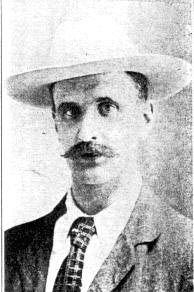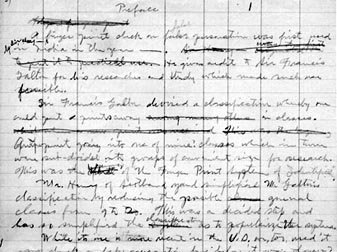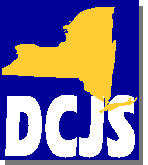The Henry System in America
Inmates at the Ossining Facility constructed cabinets for the Prison Department's Identification exhibition. In a short time, "an ornate installation of solid oak, handsomely carved," was built, transported to St. Louis, and erected in Block 5, Section 10 of the Education Building.
On opening day, May 1, 1904, fingerprint expert Captain Parke and Bertillon Indexer Emerson E. Davis demonstrated their respective methods
of identification. It was said that this was the first public demonstration of fingerprint identification in the United States.
Willing visitors at Parke's exhibit had two set fingerprints taken. . . At some later date each visitor would return to Parke's exhibit and,
without introduction, present their fingerprint sheet to Parke. The prints were then classified and the matching set located.
Throughout his seven-month stay at the fair, Parke conducted daily exhibitions of his filing method, provided formal fingerprint training and instruction in the use of his classification system, and continued his letter-writing campaign.

Det. Sgt. John Kenneth Ferrier,
Scotland Yard's fingerprint
evangelist, 1905.
|
Also at the fair, housed in a building not too far from Parke's fingerprint exhibit, was a display of the British Crown Jewels. Among the contingent of Scotland Yard Officers sent to guard Queen Victoria's Collection was Detective Sergeant John Kenneth Ferrier, who had been hand-picked by Sir Henry and sent to America with a bundle of fingerprint slips and a secret agenda--to convert the Americans to the Henry System.
. . . [Parke] was, in actuality, little more than a bookkeeper who dabbled in fingerprints. Ferrier, on the other hand, was a police officer and qualified trainer, formally schooled in all aspects of
fingerprint science. . . while Parke was aged and reserved, Ferrier was young and in possession of a type of frantic energy commonly reserved for religious fanatics. . . He gathered a small, devout group of followers and taught them to teach others.
Mary and Phil Holland of the Holland Detective Agency, Edward Evans (Superintendent of the National Bureau of dentification) and his brothers Emmett and William, all studied extensively with Ferrier during his stay in St. Louis. Before returning to England at the end of November, Ferrier saw several police agencies adopt fingerprint identification. All of them used the Henry system.
Parke earned a Grand Prize for his exhibit at the fair and the friendship of Captain Michael P. Evans (father of Edward, Emmett, and William) but gained no converts and made no progress toward establishing Albany as the nation's center for criminal identification.
On November 14, 1904, shortly before the end of the fair, Parke received a terse communication from Collins, reprimanding him for extravagant use of his expense account and ordering his return to Albany.
The Fingerprint Company of America
Ferrier's return to England left his fledgling fingerprint converts bereft of expert guidance. Captain Michael Evans and sons turned to Parke, whom they regarded as the resident North American expert, to fill this void. . .
Early in 1905, Parke received from Captain Evans two cartons of filed fingerprints, which Parke reviewed, corrected and returned. Evans was quick to spot the disadvantages in the large, English fingerprint slips and, encouraged by Parke, converted to an 8 x 8 inch fingerprint card which has since become the standard format.
The Evans' also negotiated for Parke to do some private fingerprint consultation for the Theil Detective Agency of Chicago. . . Parke applied for a patent, claiming his unique system provided a simple and secure method of proving identification.

Manuscript page, in Edward Parke's handwriting, from
Parke's book on fingerprint classification.
|
Throughout 1905, he and his son Edward wrote several chapters of a book detailing Parke's fingerprint classification system and Parke himself began attempting to interest banks, hotels and other businesses in "The Fingerprint Identification Company of America."
All of this came to nothing. Negotiations with the Theil Detective Agency fell through, the US Patent Office rejected his petition, the book was never completed and no one bought into his Fingerprint Identification Company.
Parke was reprimanded by Superintendent Collins for his activities. He was not chosen to attend the Chiefs Convention in Washington, DC, and when the Chicago Civil Service Commission decided to organize the first Fingerprint Examiner Test, Parke was completely ignored in favor of Mrs.
Holland and Mr. Brennan, another of Ferrier's students. . .
By 1906, the Henry System had been adopted by numerous police agencies and prison departments throughout the country. Captain Parke, and his fingerprint system, had lost their advantage.
On January 1, 1907, three years after rejecting Parke's suggestion, the US Navy adopted fingerprints and subsequently hired the first professional Fingerprint Trainer in the United States: Mary Holland.
Ironically, although Parke had successfully encouraged other organizations to drop Bertillon measurements in favor of fingerprints, New York's Department of Prisons continued to use Bertillonage as their official means of identification. Parke's fingerprint file operated merely as an auxiliary within the Bureau.
Gradually, Parke was returned to his official duties as parole statistician. With no one available to take over his fingerprint work, Parke's files became neglected.
On October 1, 1914, Parke resumed his residence in Whitehall and transferred to Great Meadow as a prison guard. Poor health forced him to retire in October 1916; he lived the remainder of his life in his family home, a reclusive, bitter man.
|



